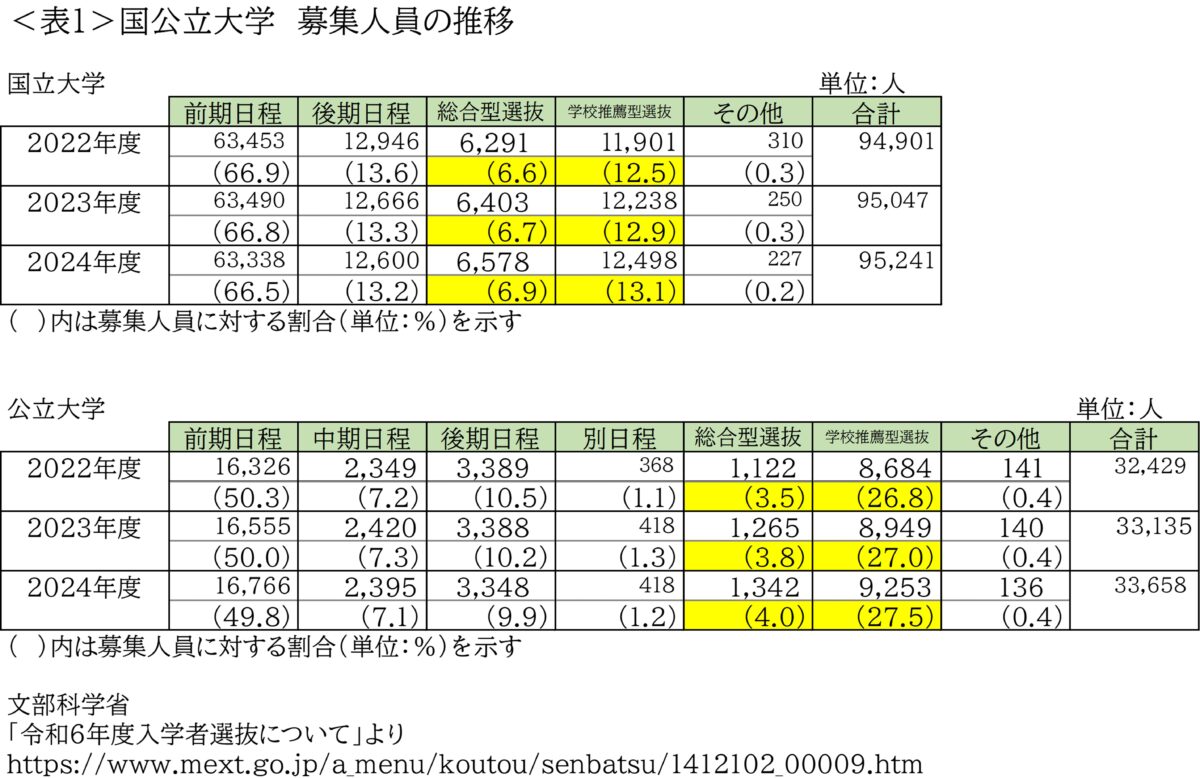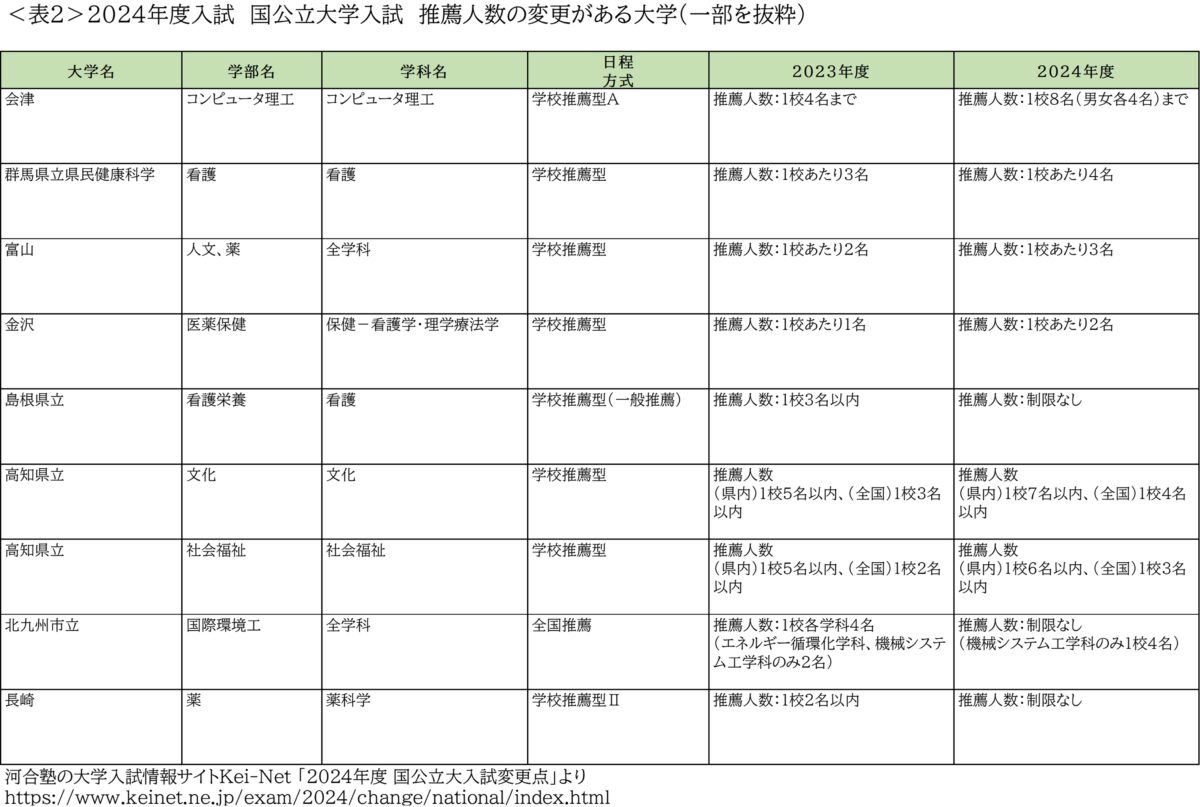Applications for school recommendation selection will begin in November.In recent years, the scale of so-called in-year entrance exams, such as comprehensive selection and school recommendation selection, has expanded.In addition to the number of applicants, the number of people each university is recruiting is also expanding. The number of applicants continues to increase at national and public universities for the 11 entrance exam.In school recommendation-based selection, there is generally still a limit to the number of people that can be recommended from one high school, but if the high school that sends students wants to expand the number of students, it is recommended to consult with the university first. It is important.

The number of people recruiting national and public universities for entrance examinations within this year continues to increase.
According to various surveys regarding private university entrance examinations, the number of applicants, number of applicants, and number of successful applicants continue to increase for the so-called XNUMX entrance examinations, which are comprehensive selection and school recommendation selection.This trend is the same for national and public universities.Looking at the data released by the Ministry of Education, Culture, Sports, Science and Technology in September regarding the selection of students admitted to national and public universities in XNUMX, the number of applicants is increasing year by year at national and public universities.

Looking at the overall ratio of applicants for comprehensive selection, national universities have increased from 6.6% to 6.7% to 6.9% over the past three years (Table 3.5).Public universities have also increased from 3.8% to 4.0% to 12.5%.On the other hand, the ratio of school-recommended applicants to national universities has increased slightly from 12.9% to 13.1% to 2,000%, but the proportion of applicants has expanded to more than 26.8%.The total number of students exceeds 27.0, which is a large number when considering entrance exams.The recruitment ratio for public universities is even higher, from 27.5% to XNUMX% to XNUMX%.Public universities have a small number of recruits overall, so the total number of recruits for school recommendation selection is less than XNUMX people, but even so, it is already second in size to the previous period in terms of ratio, so it has a strong presence. It is a number with .
Looking at <Table 2024>, the ratio of applicants for the first semester of the 50 entrance exam at public universities is small, but below 68%.If we add in the number of applicants for the mid-term, late-term, and other schedules, the number will be 50%, so while those who have passed the academic achievement test are still the mainstream, considering that the number of applicants for the latter-term will likely decrease in the future. , I think it is a major turning point that the ratio of applicants for the first semester, which was previously considered to be the main entrance examination, has fallen to less than XNUMX%.
Comprehensive selection is often mentioned when it comes to entrance exams within the year, and comprehensive selection is also often mentioned in the ``Collection of Good Case Studies in Selection of University Admissions'' provided by the Ministry of Education, Culture, Sports, Science and Technology.However, looking at the number of applicants, in reality, school recommendation-based selection is the mainstream for entrance exams within this year.This seems to be influenced by the thinking of the universities that conduct the entrance exams.In particular, there seems to be a belief among national and public universities that if they implement comprehensive selection, they must use some special method for selecting new students.For this reason, there may be some reluctance to implement a new comprehensive selection method, considering various costs.
[Ministry of Education, Culture, Sports, Science and Technology] About good practices in university entrance examination
https://www.mext.go.jp/nyushi/#r3koujirei
If the number of desired students exceeds the recommended number of students at the high school,
In school recommendation-based selection, there is often a limit to the number of people who can be recommended.There are various patterns of restrictions, but there are cases where the number of students is limited by high school, such as XX students from one high school, and cases where the number of students is restricted by high school and department, such as XX students per department from one high school. Almost.In particular, in the case of designated school recommendations, the number of applicants is often limited by high school level, so if there are more applicants than the limit within the high school for the limited number of recommendation slots, an in-school selection process will be conducted.In this case, the burden on the high school that conducts the selection process is heavy, and the damage to students who are not recommended during the internal selection process is also considerable.I think there are times when it's hard to decide which candidates to recommend.
In such cases, it is best to consult the university without hesitation.Regarding the limit on the number of recommendations, it depends on the university, but it is rare for a private university in particular not to respond to any inquiries at all.If there are multiple students who have high aspirations for the university and there is no difference in personality, most universities will listen.
When high schools consult with universities, in most cases the point of contact is the admissions department office.However, since the secretariat cannot make decisions, it is usually not possible to make a quick decision on the spot.Generally, the agreement of multiple decision-makers is required, including the chairperson of the admissions committee, the dean of the faculty/department in question, the department head professor, and the administrative director.Therefore, it will take some time (days).Some universities may require approval from the president.To those outside the university, it may seem like a rather roundabout decision-making system, but this is the general decision-making flow at universities.
Some places may not be able to handle such irregular cases.Particularly at national and public universities, where there is no provision for dealing with such cases in the internal regulations, there is no mechanism in place to consider such cases.From the perspective of people outside the university, it may be hard to believe that all you have to do is create a system, but that is what universities are all about.Still, it is meaningful to have consultations and dialogue.School recommendation selection is based on communication between high schools and universities.Even if the number of applicants does not increase that year, it will definitely have a positive impact on the following year.
Limits on the number of people are being eased, some universities have “no limit on the number of people”
The number of applicants for school recommendation selection is currently being relaxed.On Kawaijuku's university entrance examination information site Kei-Net, you can check the changes to each university's entrance examination for the 2024 entrance examination.It is a very good information site, with detailed information on changes to the entrance exams for this year.Looking at this, we can see that there are many universities that are increasing the number of people they recommend, even among national and public universities (Table XNUMX).Some of them have ``no limit on the number of people'', which improves the examination environment for examinees.

Due to this influence, it is expected that the number of applicants for school recommendation-based selection will continue to increase in the future.This will increase the burden of guidance for students at high schools.In the past, instruction was provided only by third-grade teachers, but now an increasing number of high schools are including first- and second-year high school teachers who are also providing instruction beyond the grade level they are in charge of.
However, perhaps because teaching mock interviews is generally time-consuming, I feel that interview coaching is a little weak compared to teaching documents such as a statement of purpose.Also, of course, the guidance for students applying to mid-sized private universities is a little weaker than the guidance for students applying to difficult universities.Although this is a natural way to allocate limited resources, there are some stories that are not funny.
It has actually happened that when a prospective student was asked about the reason for applying to a certain university during an interview for a recommendation, the applicant finally explained the reason for applying to a department that had stopped recruiting students due to reorganization or other reasons.School-recommended selection is based on communication between high schools and universities, so such situations can be avoided by giving students the power they need.
Many mid-sized universities believe that it is sufficient if the applicant provides a consistent explanation in his or her own words during the interview.Aside from the special selection of students admitted to special universities, such as the University of Tokyo's school recommendation selection and Kyoto University's special entrance examination, many do not expect high-level answers.Therefore, practicing using generative AI seems to be effective to some extent.Of course, we cannot leave everything to generative AI, but mock interview services using generative AI are now becoming more and more popular in the job hunting field.One idea is to start practicing using these apps during your second year of high school, when you have relatively more time.
Alternatively, I think it would be an interesting idea for universities to offer such support courses as research support/high school/university collaboration programs.If universities proactively communicate with high schools, this information will likely circulate and become positive feedback for the universities conducting recommendation interviews.
